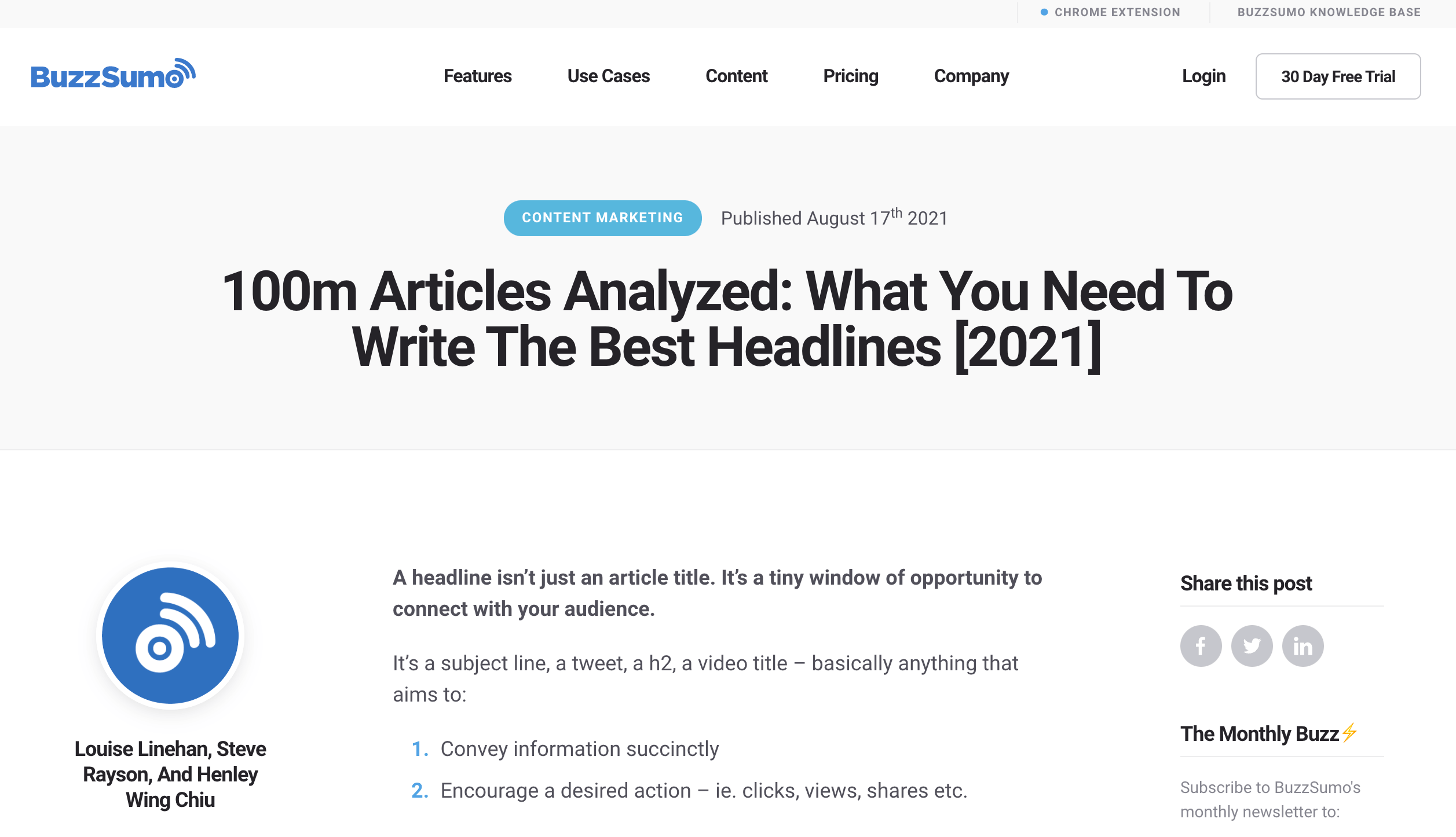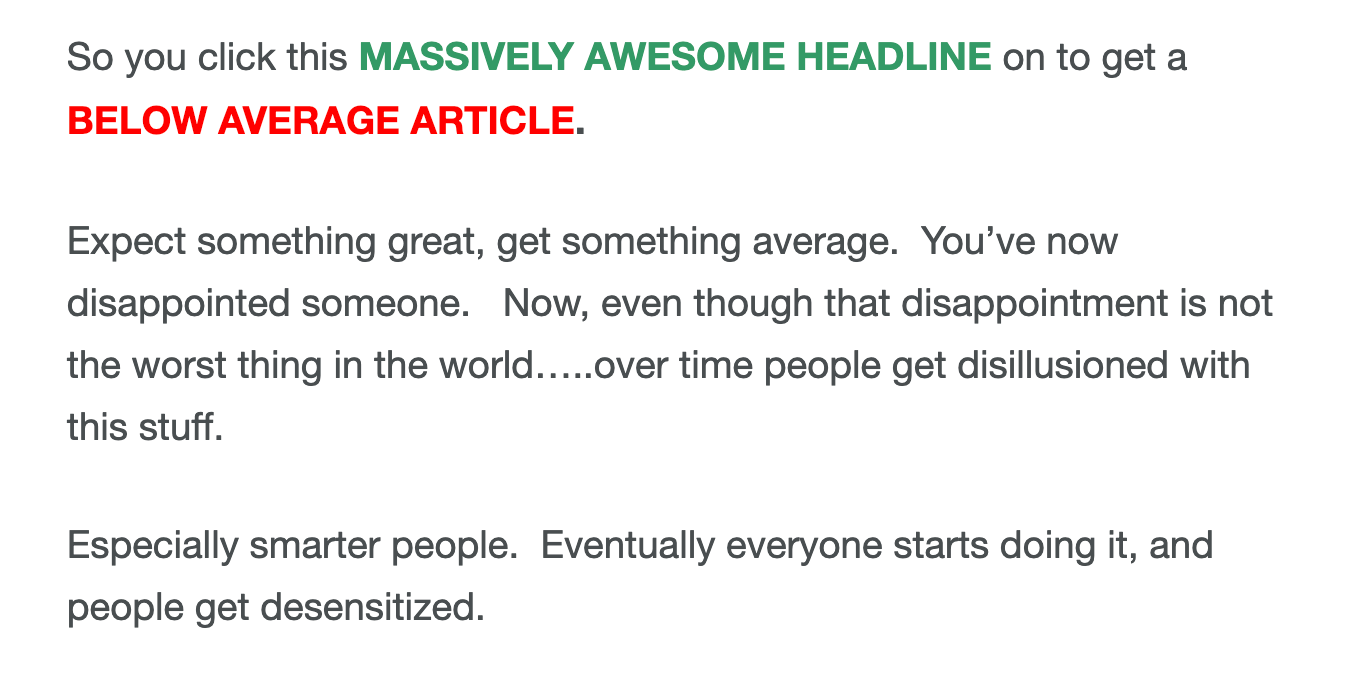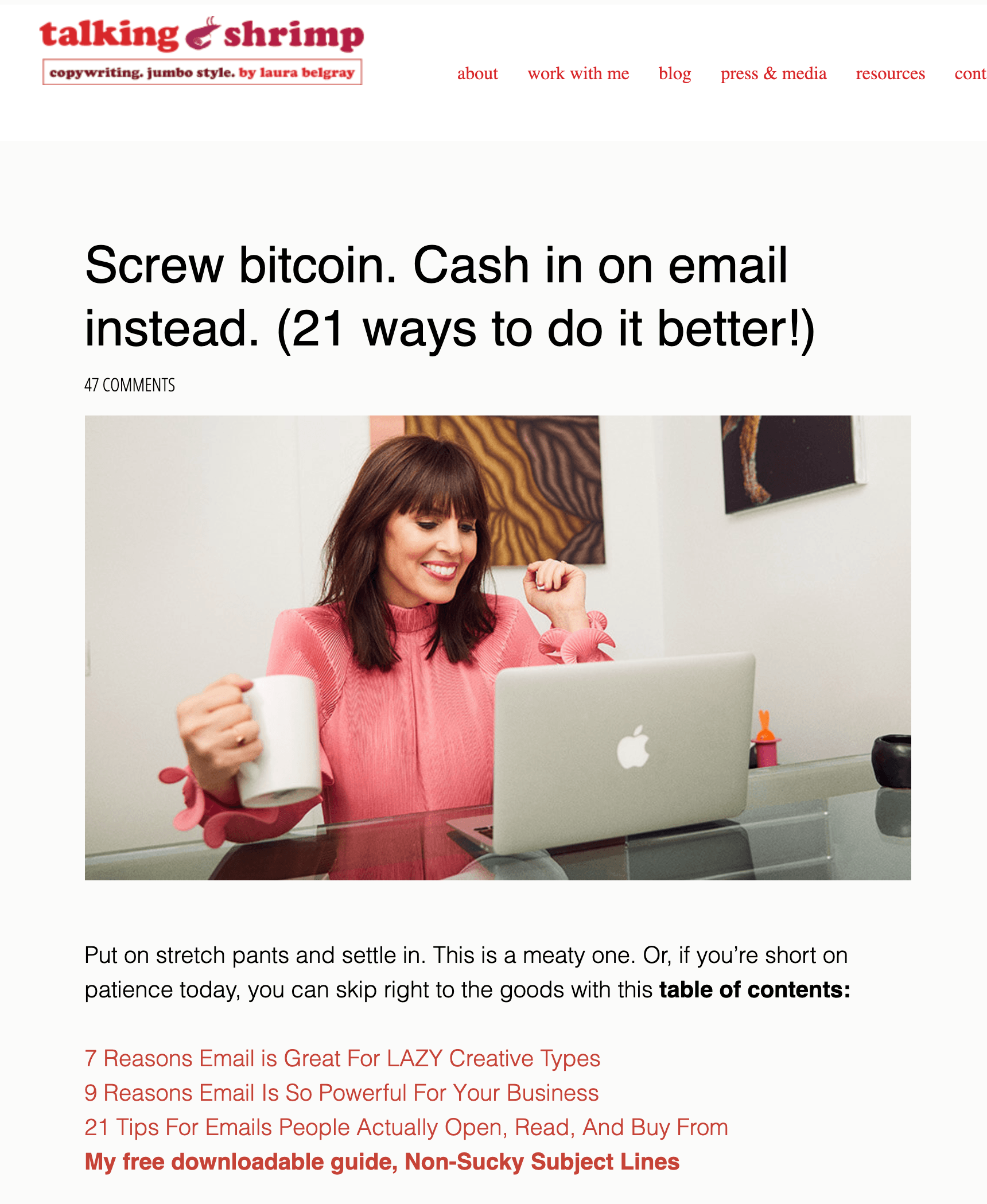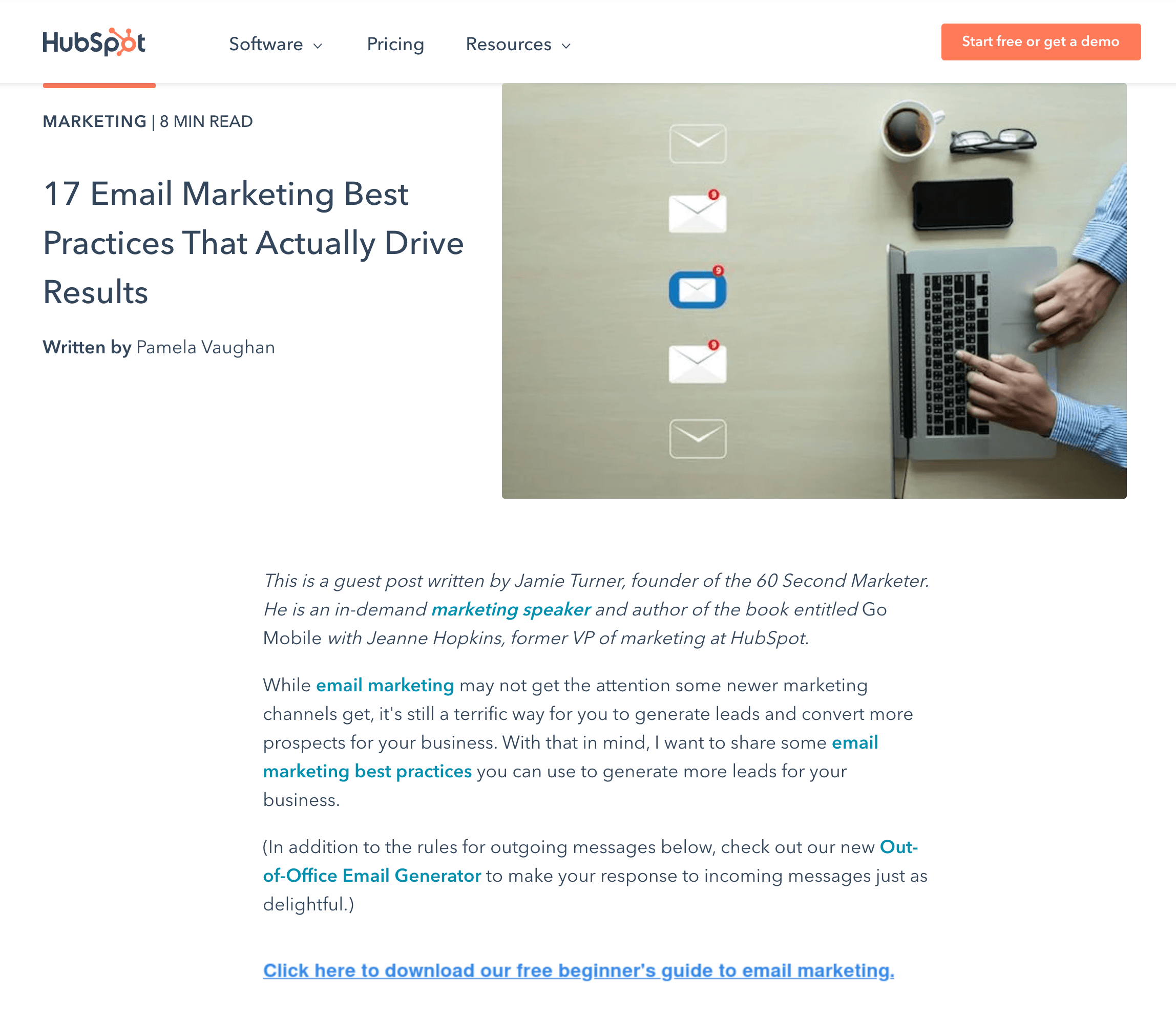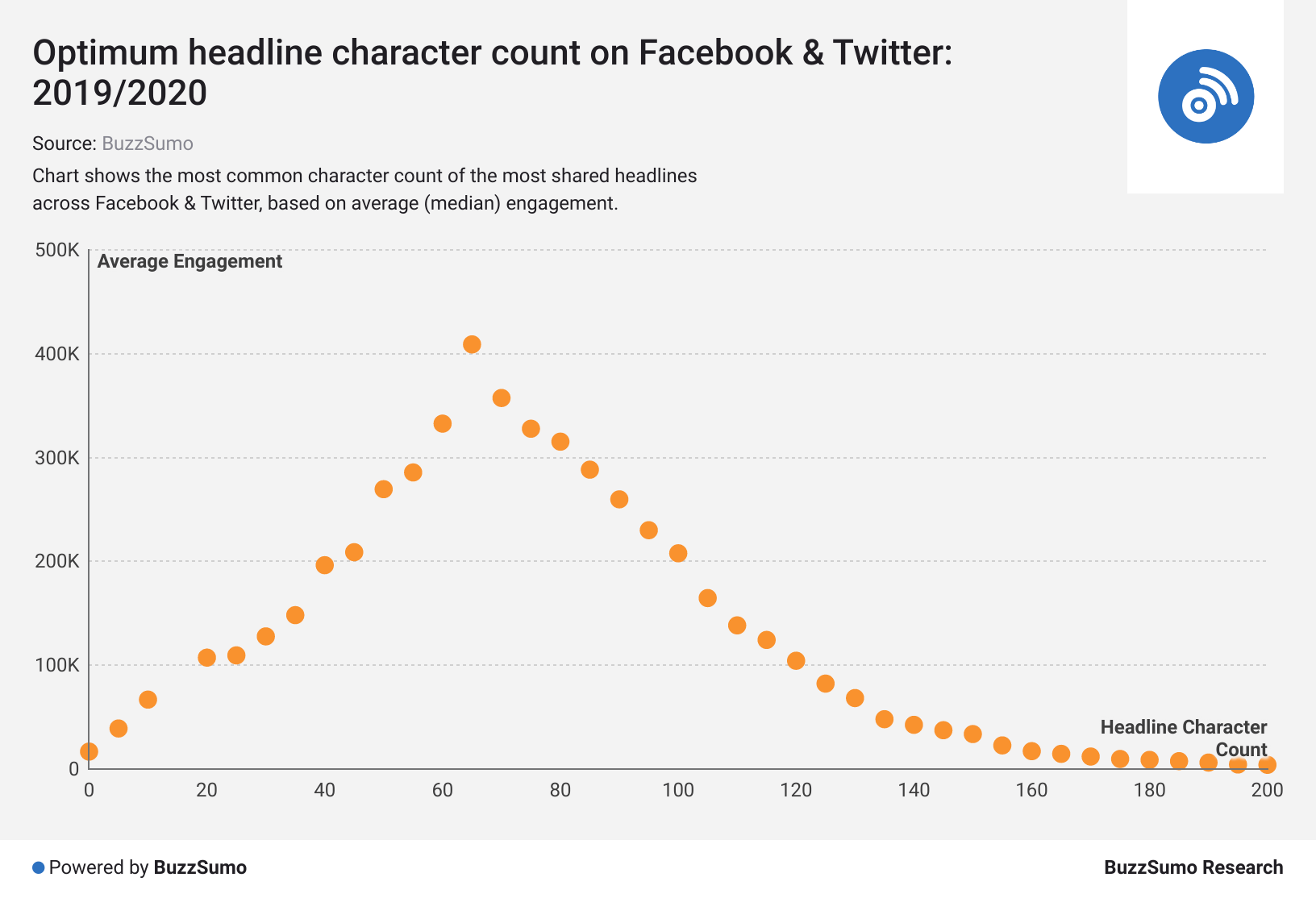Contrary to what other copywriting nerds might say, writing great blog titles is not an art form.
Leonardo da Vinci initially spent four years painting the Mona Lisa and continued to refine it over the next decade until his death. The most famous work of art was never even considered “finished” by its creator.

Fourteen years on a portrait! That’s art.
Let’s not get it twisted.
Creating great blog post titles requires a certain amount of creativity, but it’s a learnable skill — one that’s more reliant on common sense and a handful of best practices than wizardry.
And while titles are important, creating them shouldn’t take a ton of time.
We can’t teach common sense, but in this post, we’ll unpack some of our best tips to write better blog post titles faster than ever before.
But before you scroll down too far, here are two quick disclaimers.
Disclaimer 1: You Won’t Find A Monster List of Title Formulas
This post won’t overload you with popular title-writing formulas.
That’s not because we don’t believe in them. Formulas exist ;) and they can be incredibly helpful. But there are already so many swipe files and headline depositories available, most of which say nothing new.
There’s also not much about title formulas we need to add. We don’t have the magical unicorn of blog title formulas that will boost your traffic 100X. So instead of cherry-picking our favorite formulas from pre-existing lists and calling it our own, check out one of those other blog posts.
Here’s one from HubSpot that features a gorgeous infographic:
How to Write Better Headlines — HubSpot
(Be sure to check out the nifty section on “Sets of Words”.)
Disclaimer 2: You Won’t Find Exhaustive Data
There are two reasons this post will not include the results of our 18-month study that used two former Google search engineers and the most cutting edge AI to analyze what makes a great blog title:
Reason #1: We didn’t do one.
Reason #2: Most of our audience (i.e. people like you) don’t run major publishing companies that benefit most from this type of content-consumer behavior analysis. These analyses are useful to large groups because they study entire online populations. Our audience tends to have a much smaller and narrower niche they’re trying to reach.
That said, some of the data is fascinating and can be useful to anyone who writes blog posts (even if it makes you more confident about including the number 10 instead of 12 in a title.) The best analysis we’ve seen is from BuzzSumo (along with their updated version for 2021).
100m Articles Analyzed: What You Need to Write The Best Headlines [2021] — BuzzSumo
We may not be going through a massive list of headline formulas or data sets here, but we’ll give you something else: the criteria of a perfectly good blog post title and our process for creating better blog titles as quickly as possible.
3 Types of Titles
After writing, reviewing, researching, and auditing content over the last 11 years, we’ve noticed three distinct types of titles.
1. Dull Titles
These are titles where the writer didn’t try hard enough (and it’s obvious).
They may be overly vague or incomplete, such as:
- One More Thing
- I Can’t Believe It!
- This Will Change Your Business
While incompleteness may be an attempt to generate intrigue, it has a tendency of coming across as lazy.
Other titles come across as dull because they contain typos. Nothing says “this isn’t worth reading” like a title filled with spelling mistakes. Even if the content is bursting with value, typos communicate a lack of attention and diminish your credibility.
Since titles are your blog post’s first impression — and often your brand’s first impression on the reader — you don’t want to send the wrong message.
2. Obnoxious Titles
On the other side of the spectrum, there are obnoxious titles where the writer tries too hard.
These titles rely too heavily on emotion or sensationalism and rarely deliver on their promise. For example…
“15 Gmail Keyboard Shortcuts that will Radically Improve Your Life”
Really? Gmail keyboard shortcuts may save a few minutes here and there, but I doubt they’ll “radically improve” anyone’s life. Titles like this often come across as desperate and also tarnish a brand’s credibility.
Titles can also be obnoxious when they’re too long and descriptive.
“15 Gmail Keyboard Shortcuts that can Save Every Small to Medium-SIzed Business Owner 20 Minutes Per Day and Make Email Fun Again When Implemented Correctly” is very descriptive, but it’s also clunky and laborious to read.

3. Just-Right Titles
Dull and obnoxious titles are two extreme ends on a spectrum. Between these extremes, there’s a wide range of perfectly good titles.
To find this happy middle ground, we need to start with the goal. First and foremost, a blog title should get the click.
We want readers to be compelled to read the article, and since the blog title is the first thing they’ll see in a search result, it needs to grab their attention and motivate them to read the post.
The problem is, seeing the click as the only goal often leads to creating clickbait titles. These are the Machiavellian titles that use deception, bait-and-switch, or other forms of shallow intrigue to get the click.
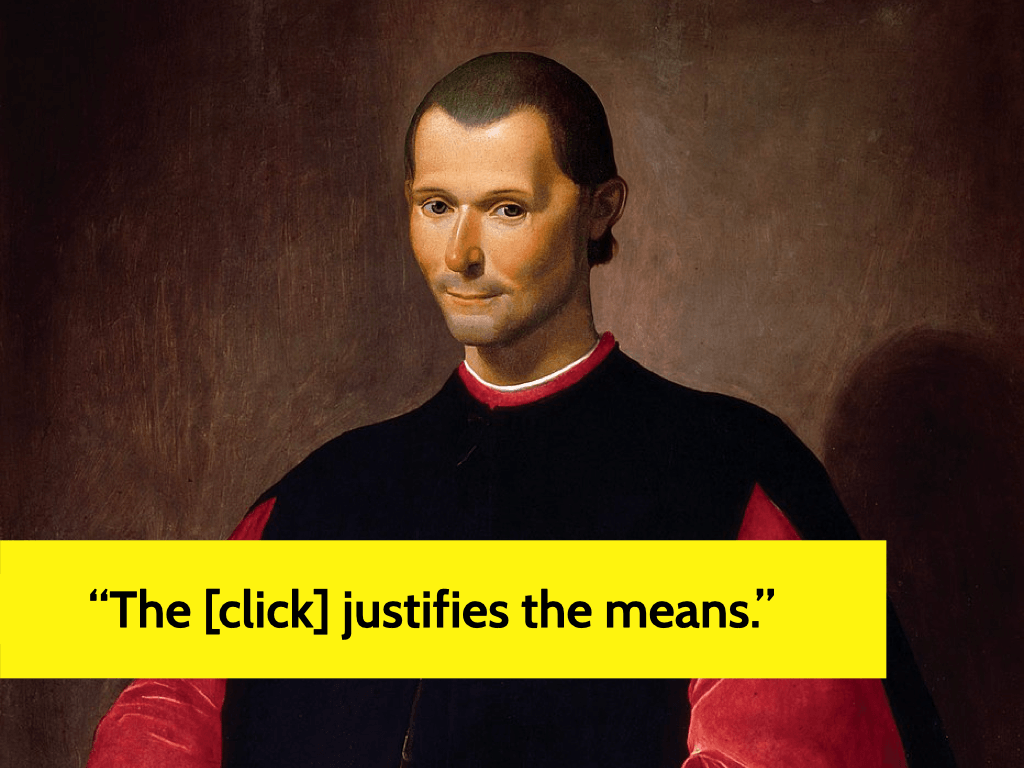
Niccolò Machiavelli (No, he didn’t actually say this.)
Clickbait headlines use a variety of tactics like open loops or sensationalism, but the content doesn’t live up to the hype and ultimately hurts your brand.
That means we need a title that gets the click in a way that aligns with our brand.
That’s a “just-right” blog title.
Think Goldilocks. Not too hot. Not too cold. Just right.
Getting a blog title just right isn’t an exact science. A perfectly good blog post title is highly subjective and dependent on the audience you’re trying to reach. There’s more wiggle room in a title than you may realize, and that should be a relief.
Some titles are better than others, and there are definitely some title formats you should stay away from. But in general, sticking to these principles will leave you with multiple options for perfectly good titles.
It’s also helpful to set some realistic expectations of what a good blog post title can and can’t do.
A good blog post title CAN’T…
Generate earth-shaking traffic on its own.
It’d be wonderful if a perfect title could cause a stampede of traffic to your blog, but that’s not how it works. There are too many factors at play like:
- Target audience behavior
- Audience size
- Promotional mix (distribution channels, paid promotion vs. organic promotion, etc)
- Subject matter
- Existing keyword volume
- Metatags
- Keyword difficulty
- Domain rating
These factors influence the potential reach of an article, so it’s unrealistic to expect a blog title to carry traffic on its own. However, the title can be the determining factor for whether the people who see will click and read.
A good blog post title also can’t make up for a bad article.
One of the standout characteristics of clickbait is that it promises one thing and delivers another. If you’re setting an expectation in a title, deliver on it in your post.
Or, as Neville Medhora puts it…
Clickbait Headlines Work For Now, But They’re Going To Die — Copywriting Course
Creating a click-worthy title is great. But if your article provides no value to the reader, what’s the point of spending time on the title at all?
On the flip side, a good blog title CAN…
Grab attention, generate interest, and compel your audience to read the article.
This is the ultimate goal.
But it comes with a caveat…
If you spend too long slaving over crafting the perfect title, it will waste time and keep you from publishing your article. This is the tradeoff. What we need is a way to credibly get the click without spending ages creating it. We can’t let perfect get in the way of good. Good is perfectly good enough.
6 Criteria of Perfectly Good Blog Post Titles
If your blog post title checks all six boxes, you’re in great shape!
1. Consistent with Your Voice
It’s important to keep your brand voice consistent across all interactions of your marketing content. But identifying and communicating “brand voice” is often very nuanced.
For a lot of businesses — especially those without a central brand figure or spokesperson (like coaches, consultants, doctors, etc.) — maintaining the company’s brand voice comes down to good writing versus bad writing rather than unique personalities or writing styles.
Regardless, if you’ve chosen to invest in any type of content marketing, you have a brand voice. Don’t forget that when writing your blog post titles.
To get the click, it may be tempting to copy someone else’s voice and style that is unlike your own. Resist the temptation! You’ll only confuse your audience.
For example, email marketing guru and copywriting badass Laura Belgray has a unique brand voice. It’s colorful, descriptive, and very personal. And her readers expect this style from her.
MailChimp has a very different voice. They cover some of the same topics on their blog, but there’s no confusing the two.
Look at these two posts — both about email marketing…
Screw bitcoin. Cash in on email instead. (21 ways to do it better!) — Talking Shrimp
17 Email Marketing Best Practices That Actually Drive Results — HubSpot
Or, here’s a shuffled list of some of their recent blog titles. Can you tell who wrote which title?
- “What If My Life is Boring?” – How To Find Great Stories For All Your Content, Even If Your Life Is Dull AF
- How to Craft a Successful Email Marketing Strategy in 2020 [Examples + Template]
- How to Avoid Email Marketing Mistakes: 6 Tips & Processes for Maintaining Quality
- I’m a born procrastinator who hates homework. Here’s how I designed a “no homework” career
- 13 Things to Check Before Hitting ‘Send’ on Your Next Marketing Email
- The Million-Dollar Email List: 21 Ways To Build An Engaged Subscriber List From Scratch—Without Facebook Ads, Instagram Ads, Or Giving A Dime To Zuck
- How to Get Existing Leads to Do Your Email Marketing for You
- For Some of Us, “A Time of Fear” is Always.
As different as these two styles are, none of these titles are inherently good or bad. Each one is written for a particular blog with a particular voice intended for a particular audience.
What works for someone else may not work for you (and that’s okay). Know your voice and keep it consistent in your blog titles.
2. Congruent with Your Content
Your blog post title must also be congruent with your content, which sounds obvious, but there are several reasons writers create incongruent or irrelevant titles.
The first, clickbait, is an issue we’ve already mentioned in this post so we won’t belabor the point. Bottom line: if the title promises something, the content better deliver or you risk losing rapport with your audience.
Incongruent titles can also come from an innocent oversight or attachment to a working title.
Writers often begin a post with a working title. Then, as they write, the article can take on a life of its own.
What started out as a post on “great email subject lines” may morph into a post about “structuring your email for maximum conversions”. While you still mention subject lines throughout the post, it’s no longer the main topic.
When the content drifts from the original idea — which is a completely natural part of writing — capture the new topic in your blog title.
Otherwise, you risk confusing your readers or keeping the content hidden from people who are seeking out the solution you actually wrote about.
3. Contains Your Keyword
Your audience is looking for information about a specific topic. When a blog post is optimized for that keyword, search algorithms display what they consider to be the most relevant, highest quality content.
A crucial part of that optimization is including the keyword in your post title. (Yes — that’s a gross oversimplification of SEO.)
But depending on your particular business model and content marketing strategy, keyword rankings may not be a top priority.
Even if you couldn’t care less about ranking for a keyword, surely you can recognize the value in helping your audience find what they’re looking for when combing through your blog. If you truly didn’t care (or you’re in the unique/unheard-of position where your audience will read anything and everything you post regardless of title), try this formula:
“Post 134: The One I Wrote After Post 133”
(I wouldn’t recommend it)
Including the keyword sounds like the most basic advice, but you’d be surprised how often it happens.
4. Compelling
The purpose of a blog post title is to get the click in a way that aligns with our brand. To do that, you need to make it interesting or attention-grabbing so that people notice it and can’t resist clicking and reading the article.

Often, when we’re instructed to “make it compelling” or “install curiosity”, we assume we need to make outrageous promises, open a loop, or use sensationalism to get a click. But again, that’s clickbait.
Fortunately, there are other ways.
Your audience is looking for an answer to their question or a solution to their specific problem. Calling out their need and the solution you’re offering is just as (if not more) compelling than baiting them with emotion.
If you can’t identify the clear need the article is addressing, there’s a valid argument for not publishing it.
Give your readers a reason to click.
5. Clear
The title must also be clear.
Crystal clear.
Sometimes we’re so intent on being compelling that we try to grab people’s attention using wordplay. This is especially true when writing posts about common topics that must compete with a magnitude of existing published content.
To stand out from the crowd, we try to get fancy, which often confuses our readers.
Aim for clear over clever.
There’s nothing wrong with making someone re-read your headline because they think it’s interesting. It’s another thing entirely if they have to re-read it because it doesn’t make any sense.
If they have to spend more than a second thinking about what you’re trying to say, you’ve lost them.
As a general rule, if it doesn’t inform readers what the article is about in one take, it’s not the right blog post title.
6. Concise
Title length is a disputed issue. While I agree that length largely depends on the particular audience and brand voice, I typically recommend shorter rather than longer titles.
Longer titles may be more descriptive, but they can bury the keyword and add confusion.
For example:
“13 Reasons You Need to Be Using a Quality Email Service Provider to Send Marketing Emails to Your Prospects that Will Boost Engagement, Increase Awareness of Your Brand, and Get Them to Move in Your Pipeline, Resulting in More Sales.”
(Catchy, huh?)
There’s also some interesting data to back this up. According to the Buzzsumo analysis mentioned above, the ideal headline length is around 11 words and 65 characters. They also acknowledge that clicks are trending towards shorter headlines.
Sounds simple, right? But just because shorter titles have fewer words doesn’t make them easier to create. The old adage, “If I had more time, I would have written a shorter letter,” definitely applies to titles as well.
Writing a short title that’s compelling and clear takes practice and a lot of trial and error. But it can be done.
Fluxe’s Non-Magical Title Creation Process
It’s easy for us to sit back and rip apart bad blog post titles, but could we really do any better? I like to think so. We follow the same process for (almost) every new post, and there’s nothing complicated, fancy, or magical about it.
It’s straightforward, effective, and fast. I hope it works for you as well as it’s worked for us!
Step 1: Review & Document
Start by taking inventory of your key information.
First, write down the primary short-tail keyword you’re trying to rank for.
Then, confirm the audience or segment this particular post is trying to reach.
You should also know exactly which problem or need you’re trying to solve/address in the content.
Now, review the main thesis. This is the big idea of your article captured in one or two sentences.
Finally, review your headings and subheadings. This will also verify that your thesis is congruent with your content. Looking at your key info from a high level keeps you from getting lost in the weeds or stuck on minor details in your post.
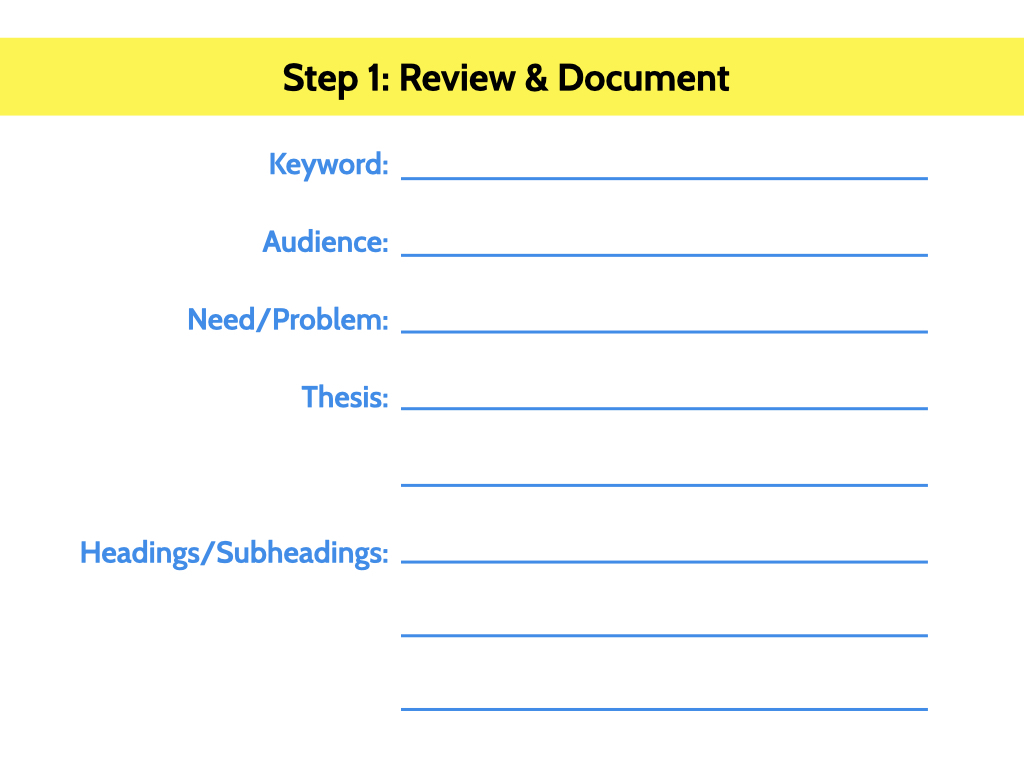
(We add this info into a table, right between the working title and body copy of the article.)
Step 2: Brainstorm
Now looking at this key information in one place, start brainstorming blog post titles. Try to create at least 5 to 10 possible titles to choose from.
At Fluxe, we start brainstorming by throwing out 3 to 5 ideas off the top of our heads. Remember, it’s not art. If it enters our head, it goes on the page.
Then we use a variety of tools to help us generate more ideas. This is where tools like Jarvis, title generators, or headline swipe files come in handy.
Here are a few resources we’ve used when stuck:
- Jarvis.ai
- Title Generator from Copywriting Course
- 13 Awesome Headlines for Business Blogging Success — HubSpot
Finally, we review our content bank to make sure nothing on our brainstorm list is too similar to a title we’ve previously published.
Step 3: Narrow & Confirm
After you have your initial brainstorm list, it’s time to narrow it down.
If you’re lucky enough to have a team, ask them which headline stands out. This outside perspective from someone on your team can be invaluable, but always keep the target audience in mind. What may sound great to your friend may not resonate with who you’re trying to reach.
After getting feedback, there will likely be two or three contenders that stand out.
At this point, you could let your audience decide the headline through split testing. There are several great WordPress plugins for this. We recommend Thrive Optimize, but there are plenty of other options.
(NOTE: Split testing works best for sites with a lot of traffic, so it may not be worth the trouble for smaller blogs with little traffic.)
If you decide not to split test, choosing the final headline from a narrowed list becomes a judgment call. This may sound overly optimistic or just downright cheesy, but as long as the title meets the six criteria — consistent with your voice, congruent with your content, contains your keywords, compelling, clear, and concise — you won’t make a bad choice.
But What About Faster?
I’ve read that you should spend just as much time writing your title as you do on the post itself.
In my opinion, that’s not realistic — especially if you’re publishing two or more substantial posts per month and have any other responsibilities. (But to each their own.) After practicing this process a few times, you should create blog titles that get clicks in about 15 minutes.
Writing blog post titles is not an art form or a high science. They don’t need to be perfect! Only spend as much time and mental energy as necessary to create a title that gets the click in the right way. Then, move along.



